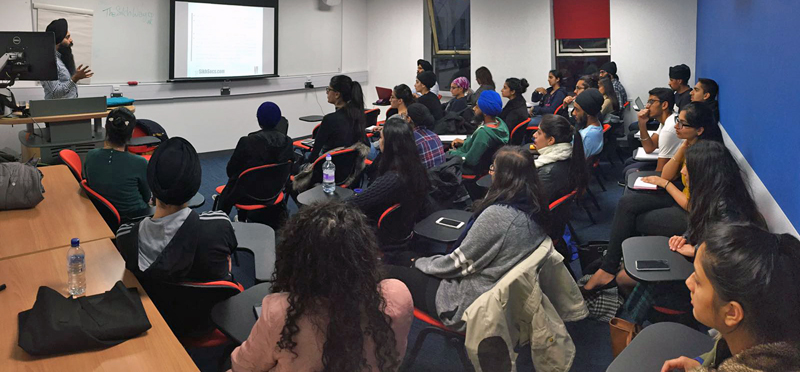Another year of teaching Sikh Studies is under way for me and my colleagues at the Sikh Education Council. In addition to offering the course to University Sikh societies through Nishaan, we also enrol non-students and professionals on to the course elsewhere and host monthly seminars on a range of topics. It can be a lot of work, but is beneficial, not only for the students, but for ourselves as voluntary organisers because we are constantly exposed to new people, opinions and learning, most of which emanates from the young people we encounter.
I’ve experienced Sikh Education Council events over the last three decades and it has never been as exciting as it is right now, thanks to the advancement of communications and the internet. My students can access a world of reference material from their mobile phones no sooner than I link to it on the white board, and have the opportunity to ask questions and express their opinions in any number of ways, at any time. Whilst these developments are now commonplace in education across the board, for students of Sikhi they are especially vital. Throughout the nineteenth and twentieth centuries, the dispensation of knowledge in Sikhi increasingly became the preserve of an unchallengable few, which was ironic because it was exactly this type of hierarchy that Guru Nanak stood against. With greater access to material and content, a sense of freedom is now returning and some of the myths that constitute how the World sees Sikhs are being countered. It is in this context that I would like to acknowledge and recognise the zeal for learning that young people in Sikhi have, which is not always shared by older generations.
In eight years of teaching Sikh Studies to University students, the number of individuals enrolling and attending has never been higher. A few weeks ago, I delivered an introduction to both Sikhi and our Sikh Studies course to around 75 students in total, whilst the first class in the fourteen week calendar was standing room only, attended by just under thirty students. Yes those numbers will drop considerably, but if past ratios are anything to go by, I’m looking at around twenty solid students throughout this year. Some of you reading this might scoff at those numbers, thinking of the hundreds of ‘Sikh’ students that are enrolled at Universities in London, but what you have to consider is that this is a formal course of study, steeped in references and concepts that are not easily comprehended by the average student at an institution of higher learning after a long day of separate degree studies. “Not everybody at University is into books“, as my father would say, nor need they be. But to have more than the half a dozen serious students that my early years of teaching the course garnered, is in my opinion a sign of the changing times. One also needs to consider that although this course might not be for everybody, it doesn’t mean that Sikh Studies is not. Students might not like my voice, my face, or the style in which I teach, and that’s OK! Increasingly I’m finding young people look elsewhere or actively engage in self study.
Contrary to what I’m seeing, young people in Sikh circles are still derided, undeservedly so in my opinion. But this is not new; just as dangers and vices lurk around every corner for the youth of today, so have they for every previous generation, just in a different guise. Older generations tend to look down at younger generations, or rather they suspect and fear for what they might be susceptible to; it’s common and perhaps even natural. Today the argument is that for all the greater access and opportunities to learn that technological advancements have brought, they have also created new challenges, from easily accessible porn to unfettered gambling, targeted sexual grooming to hate-preaching extremism. I would respond that technology has allowed organisations and safe spaces to emerge on a similar scale, to counter at least some of these. But besides that point, we would do well to remember that every young person is not a drug addict, or an alcoholic, or the victim (or perpetrator) of revenge porn, to take a few examples. Unfortunately, I continue to hear it said by some speakers that they are able to reach young people because they themselves once led a life mired in the proverbial sex, drugs and rock’n’roll. Not only is this statement insulting to the numerous young people who aren’t that way inclined, but it suggests that in order to reach the vulnerable and troubled in our community, one has to have themselves been troubled in their youth, thus proposing the perpetuation of a never-ending cycle of problems. The truth is some young people face horrendous difficulties, some not of their own making, but unlike previous generations they have umpteen outlets at their disposal to help work though those problems and come out on the other side.
Young people, just like older generations, might not be saints, but there are plenty of them who are exploring the new World we live in in a way that Sikhs should celebrate; I wanted to write this piece as a reminder to myself of that. For every student who turns a blind eye to their conscience, who thinks not with their analytical faculties instead maintaining the status quo, there is another who reads, writes, publishes and reviews. There is no need to fear them or for them, for young people are doing what young people have always done: find their feet themselves. In my book, the kids are alright.






